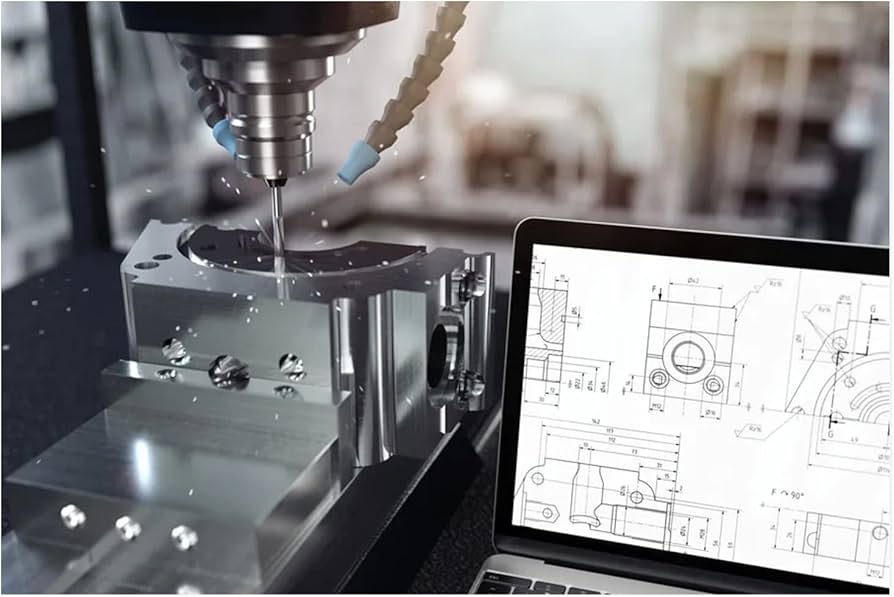In the world of CNC milling, precision is paramount. Advanced bridge machining center designed to meet this demand, offering high accuracy and stability for a wide range of industrial applications. These machines stand out in their ability to handle large workpieces also this tool maintaining exceptional precision. This article delves into the features, benefits, applications, and considerations for choosing advanced bridge machining centers.
What is a Bridge Machining Center?
A bridge machining center features a unique design that consists of a bridge-like structure spanning over the workpiece. This configuration allows the spindle to move freely in multiple directions while ensuring stability and minimizing vibrations. The design is ideal for machining large components, making it a preferred choice for industries that require high precision and the ability to handle substantial weight.
Key Features of Advanced Bridge Machining Centers
Advanced bridge machining centers are equipped with several features that enhance their performance and versatility. Understanding these features can help manufacturers make informed decisions when selecting a machining solution.
Sturdy Structure
The robust structure of this tool is designed to absorb vibrations and maintain rigidity during machining operations. This stability is essential for achieving high-quality surface finishes and tight tolerances. The heavy-duty materials used in construction ensure durability, allowing these machines to perform consistently in demanding environments.
Multi-Axis Capabilities
Most advanced bridge machining centers offer multi-axis capabilities, enabling them to perform complex machining tasks. With the ability to move along the X, Y, and Z axes, these machines can execute intricate cuts and shapes with precision. The flexibility of multi-axis machining reduces the need for multiple setups, improving efficiency and saving time.
High-Speed Spindles
Many modern bridge machining centers are equipped with high-speed spindles, allowing for faster cutting speeds and improved productivity. These spindles are designed to handle various materials, from aluminum to hardened steel. The ability to increase cutting speeds without sacrificing quality is a significant advantage in today’s competitive manufacturing landscape.
Advanced CNC Control Systems
The integration of advanced CNC control systems enhances the functionality of bridge machining centers. These systems allow for precise programming and automation of machining tasks. Operators can create complex machining paths, monitor performance in real-time, and make adjustments as needed. This level of control minimizes errors and improves overall productivity.
Versatile Tooling Options
Bridge machining centers are compatible with a wide range of tooling options. This versatility allows manufacturers to customize their machines for specific applications. Whether it is milling, drilling, or tapping, advanced tooling options enable operators to execute various tasks efficiently.
Advantages of Using Bridge Machining Centers
Choosing an advanced bridge machining center offers several advantages that contribute to improved manufacturing processes.
Enhanced Precision
Precision is critical in industries such as aerospace, automotive, and medical device manufacturing. Bridge machining centers provide the stability and accuracy needed to produce components with tight tolerances. The design minimizes deflection and vibration, resulting in parts that meet strict quality standards.
Increased Efficiency
With the capability to handle large workpieces and execute complex machining tasks, bridge machining centers significantly increase production efficiency. The multi-axis design allows for faster machining cycles and reduces the need for multiple setups. This efficiency translates to shorter lead times and lower production costs.
Improved Surface Finish
The structural integrity of bridge machining centers contributes to superior surface finishes. The combination of stability, high-speed spindles, and precise tooling results in components that require minimal post-processing. Achieving a high-quality surface finish is essential for many applications, enhancing both aesthetics and functionality.
Greater Load Capacity
This tool specifically designed to accommodate heavy workpieces. The sturdy construction supports significant loads, making them ideal for machining large components in industries such as construction, energy, and aerospace. This increased load capacity allows manufacturers to expand their machining capabilities.
Flexibility in Applications
The versatility of bridge machining centers makes them suitable for various applications across different industries. From aerospace components to heavy machinery parts, these machines can perform a wide range of tasks, making them a valuable asset for manufacturers looking to streamline their production processes.
Applications of Bridge Machining Centers
Bridge machining centers are used in various industries due to their precision and ability to handle large-scale projects.
Aerospace Industry
In aerospace manufacturing, the need for precision and reliability is critical. Bridge machining centers enable manufacturers to produce large components, such as wing sections and fuselage parts, with high accuracy. The capability to machine complex geometries ensures that parts meet stringent safety and performance standards.
Automotive Industry
The automotive sector relies on bridge machining centers for producing engine components, chassis parts, and other large assemblies. The precision offered by these machines ensures that components fit together correctly, contributing to overall vehicle safety and performance. Furthermore, the ability to handle heavy materials such as steel and aluminum is essential for automotive manufacturing.
Heavy Machinery Production
Manufacturers of heavy machinery benefit significantly from bridge machining centers. These machines allow for the precise machining of large metal parts integral to the functionality and durability of equipment such as excavators and tractors. The robust design ensures that components are manufactured to withstand demanding operational conditions.
Energy Sector
In the energy sector, the production of large components such as turbines and generator housings requires precise machining. Bridge machining centers provide the necessary stability and accuracy to create these complex parts, making them indispensable in energy-related manufacturing. The ability to machine large workpieces efficiently contributes to the overall effectiveness of energy production.
Tool and Die Manufacturing
Bridge machining centers are also utilized in tool and die manufacturing, where precision is paramount. The ability to create intricate shapes and profiles ensures that molds and dies are produced with high accuracy. This capability is crucial for industries that rely on precise tooling for production processes.
Considerations When Choosing a Bridge Machining Center
When selecting an advanced bridge machining center, several factors should be considered to ensure it meets your production needs.
Workpiece Size and Weight
Evaluate the maximum size and weight of the workpieces you plan to machine. Choosing a bridge machining center with an appropriate bed size and load capacity is essential to accommodate your largest components.
Precision Requirements
Consider the precision requirements specific to your applications. Different bridge machining centers offer varying degrees of accuracy. It is crucial to select a model that can deliver the level of precision required for your industry.
CNC Control Systems
The control system is vital to the functionality of any CNC machine. Opt for a bridge machining center with an advanced CNC control system that supports the level of customization and automation your operations require. Features like user-friendly interfaces and intuitive programming capabilities can enhance productivity.
Tooling Compatibility
Ensure that the bridge machining center you choose is compatible with the tooling required for your machining tasks. Some machines offer customizable tool magazines that can accommodate a range of tools for different applications. This flexibility is beneficial for maximizing efficiency.
Manufacturer Support and Maintenance
Investing in a bridge machining center is a long-term decision. Ensure that the manufacturer provides reliable support and maintenance options. Regular maintenance will help keep the machine in optimal condition, ensuring consistent performance and longevity.
Conclusion
Advanced bridge machining centers represent a critical solution for manufacturers seeking high-precision CNC milling capabilities. With their robust design, multi-axis capabilities, and enhanced stability, these machines are ideal for a wide range of industrial applications. As industries continue to evolve and demand greater precision and efficiency, bridge machining centers will play an increasingly vital role in manufacturing processes. Investing in this technology can lead to improved production outcomes, higher quality components, and greater competitiveness in the market.




